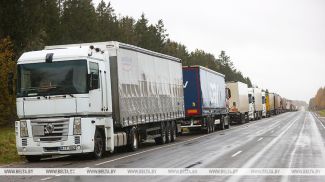MINSK, 21 October (BelTA) – Memorials will be put up in all newly discovered war burial places, Belarusian Prime Minister Roman Golovchenko told the media in Minsk on 21 October, BelTA has learned.
“We thought that our predecessors had done enough to establish all the commemorative places associated with the Great Patriotic War, to monumentalize the places of mass executions of the Belarusian people. Indeed, a lot of work has been done, but the scale of this tragedy is so great that, probably, over all the post-war years, the Soviet Union and the independence of Belarus could not uncover all the facts. Taking into account the new facts and circumstances that we continuously discover, this work will take many years to come," Roman Golovchenko said.
"The entire Belarusian land was a witness to the crimes of the invaders. This work [to establish burial places of the Great Patriotic War] has been intensified within the framework of the criminal case initiated by the Prosecutor General's Office to investigate the genocide of the Belarusian people. In a short period of time, starting from the summer, a lot of work has already been done and new terrible facts from those days are being discovered. This work will be continued until all the places of execution of civilians and prisoners of war on the territory of our country are established. In the future, all places that have so far been unknown will be monumentalized. The memory of the victims who were killed there will be perpetuated. Prosecutors will enter all the new evidence into the criminal case in the genocide of the Belarusian people of 1941-1944," Roman Golovchenko noted.
On 21 October, in the forest near the training ground of the 120th Independent Guards Mechanized Brigade, bone remains and other items are being examined and removed from a burial place discovered during the investigation of the genocide case.
During the investigation of the criminal case the Prosecutor General's Office has uncovered the information about at least seven mass burials places of civilians near the Uruchye forest. According to the archival information, the number of people buried there from 1941 to 1944 exceeded 38,000. A thorough analysis of the information from various sources made it possible to find one of such places - in the forest near the training ground. It may contain the remains of more than 8,000 people.
“This particular site is of great importance. This is a rather big mass grave in terms of the number of Nazi victims. Until now, we knew about several mass graves in the vicinity of Minsk. They include the famous Trostenets camp, a camp in Masyukovshchina, and a camp in Drozdy where Soviet prisoners of war were executed. This is probably the fourth such place. The Extraordinary Commission to Investigate the Crimes of the Nazi Invaders that was put together immediately after the war, established places of mass execution of civilians and Soviet prisoners of war on the territory of the BSSR. Many mass graves were discovered. But unfortunately, the commission did not do enough to document and monumentize them. Obviously, they had many other things to do as the country lay in ruins. Thus, the information about the whereabouts of these graves was lost. It was known that there should be a mass grave somewhere here and the obelisk that was installed along the highway (Moscow direction) nine kilometers from Minsk commemorates mass executions.
According to Roman Golovchenko, soldiers and prosecutors performed a great deal of work to identify the site of the mass shooting of Soviet citizens. “Work to identify the remaining pits-graves will be continued. According to the commission's estimates, at least 30,000 citizens (civilians, soldiers) are buried here. The work to establish their names will be continued and, of course, their memory will be perpetuated. We have not decided yet, but it will be either their reburial to the existing memorials or the creation of a new memorial. It depends on many factors. In such places you feel particularly strongly about what happened to our people, what trials they had to survive and how inhumane the aggressors, the invaders were. It happened quite recently by historical standards. It is a living memory. Here you get a feeling that our tortured ancestors look down on us from above and probably give us this chance to remember and to preserve this memory, to make sure that such things never happen again,” he added.
Excavations will continue until all the circumstances of the atrocities that took place here during the war are established.













